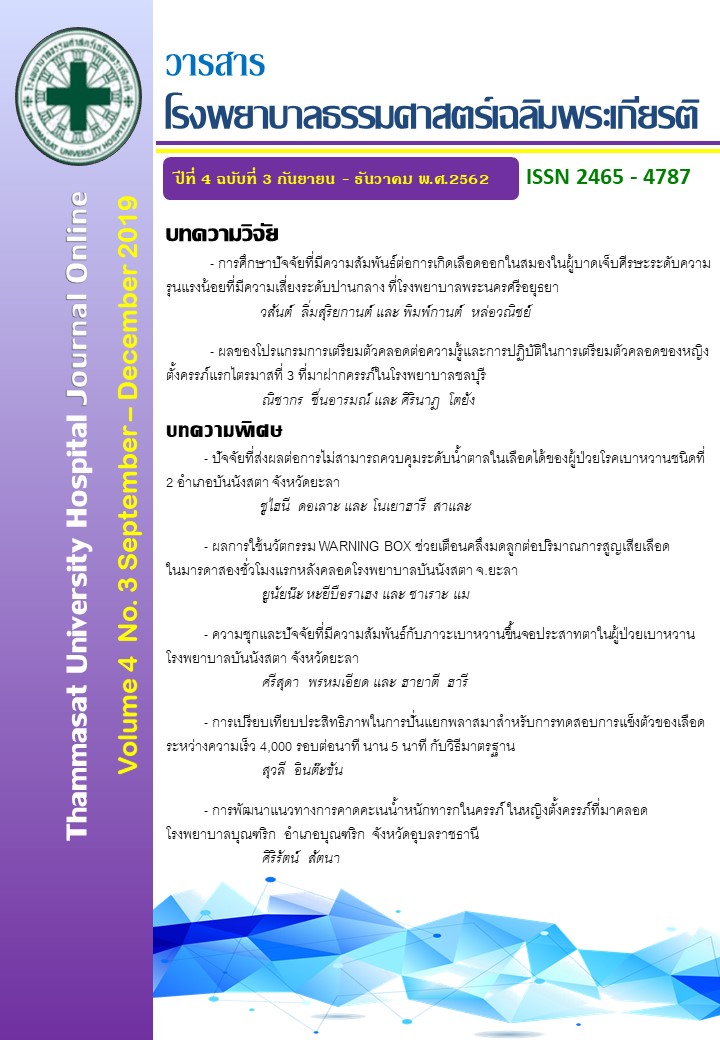Factors associated with intracranial hemorrhage in mild traumatic brain injury moderated risk patients at Phra Nakhon Si Ayutthaya Hospital
Keywords:
Mild head injury, moderate risk, CT brain, Intracranial hemorrhageAbstract
Backgrounds: Mild head injury patients sent are often for the computed tomography (CT scan) of the head this has led to unnecessary expenses. Moderate and high-risk traumatic head injury patients should be assessed prior head CT scan. There is a study to describe relevant factors to intracranial hemorrhage in mild head injury.
Objective : To study factors associated with presence of intracranial hemorrhage in a mild head injury with moderate risk at Phra Nakhon Si Ayutthaya Hospital.
Material and Methods : This is a retrospective cohort study of 423 patients who was diagnosed as mild head injury with moderate risk at Phra Nakhon Si Ayutthaya Hospital.
Result : Four hundred twenty three patients included in this study, comprise of 26 (6.1%) cases with abnormal brain computed tomography and 397 (93.9%) patients without brain abnormality. They are predominantly male (60.8) %, and 22.7 % had an underlying disease with 29.1% current NSAID used, 29.1% used aspirin and 7.1% used warfarin.The motorcycle accident was the common mechanism (66.9 %). Significant factors associated with the presence of intracranial hemorrhage in mild head injury patients were 1) systolic blood pressure 140 - 179 mmHg (adjusted risk ratio (RR) 7.3, 95% confidence interval (CI); 2.1-25.1, p=0.001), 2) systolic blood pressure more than 179 mmHg (RR) 19.2, 95% CI; 6 – 61.1, p<0.001), (3) warfarin usage (RR 1.9, 95% CI; 1.3 – 2.7, p<0.001), 4) suspected base of skull fracture (RR 1.9, 95% CI; 1.2 – 3.2, p=0.011), (5) fall mechanism (RR 2.5, 95% CI; 1.5 – 4.2, p<0.001), and 6) fall from hight (RR 2.4, 95% CI; 1.4 – 3.9, p=0.001).
Conclusion : Factors associated with intracerebral hermorrhage in mild head injury with moderate risk patients were blood pressure more than 140 to more than 179 mmHg, warfarin usage, mechanism of trauma such as fall and fall from hight and patients who have sign of base of skull fracture.
References
สถิติการบาดเจ็บรุนแรงจากอุบัติเหตุขนส่ง พ.ศ. 2550 (severe injury due to transport accident 2007). โรงพยาบาลเครือข่ายเฝ้าระวังการบาดเจ็บรุนแรง 28 แห่ง สํานักระบาดวิทยากรมควบคุมโรค กระทรวงสาธารณสุข : 2550.
โรงพยาบาลพระนครศรีอยุธยา.รายงานการเฝ้าระวังการบาดเจ็บโรงพยาบาลพระนครศรีอยุธยาปี 2552-2558. พระนครศรีอยุธยา :โรงพยาบาลพระนครศรีอยุธยา : 2559.
Levin HS. Outcomes from mild head injury. In: Narayan RK, Wilberger JE, Povlishock JT, editors. Neurotrauma. New York, NY: McGraw-Hill; 1996.
Haydel MJ, Preston CA, Mills TJ, et al. Indications for computed tomography in patients with minor head injury. N Engl J Med 2000; 343:100-105.
Stiell I, Clement C, Rowe B, et al. Comparison of the Canadian CT Head Rule and the New Orleans Criteria in patients with minor head injury. JAMA 2005;294:1511-1518.
American College of Surgeons. Advanced Trauma Life Support, Student course manual: 9th edition [internet]. 2018 [cited 2018 Dec 5] Available from: https://am-medicine.com/2015/06/advanced-trauma-life-support-atls-student-course-manual-9th-edition-pdf.html.
Smits M, Dippel DW, de Haan GG, et al. Minor head injury: guidelines for the use of CT. A multicenter validation study. Radiology 2007; 245: 831–838.
Stiell IG, Wells GA, Vandemheen K, et al. The Canadian CT Head Rule for patients with minor head injury. Lancet 2001;357:1391-1396.
Mower WR, Hoffman JR, Herbert M, et al. Developing a decision instrument to guide computed tomographic imaging of blunt head injury patients. J Trauma 2005;59:954-959.
Smits M, Dippel DW, de Haan GG, et al. External validation of the Canadian CT Head Rule and the New Orleans Criteria for CT scanning in patients with minor head injury. JAMA 2005;294:1519-1525.
Stein SC, Fabbri A, Servadei F, et al. A Critical Comparison of clinical decision instruments for computed tomographic scanning in mild closed traumatic brain injury in Adolescents and AdultsEmerg Med 2009;53:180-188.
Haydel MJ, Preston CA, Mills TJ, et al. Indications for computed tomography in patients with minor head injury. N Engl J Med 2000;343:100–105.
Marion S, Diederik WJ., Ewout W S, Gijs GH, Helena MD, Pieter EV, et al. Predicting intracranial traumatic findings on computed tomography in patient with minor head injury: The CHIP Prediction Rule. Ann Intern Med 2007;146:397-405.
Ro YS, Shin SD, Holmes JF, et al. Comparison of clinical performance of cranial computed tomography rules in patients with minor head injury: a multicenter prospective study. Acad Emerg Med 2011;18:597-604.
Pandor A, Goodacre S, Harnan S, et al. Diagnostic management strategies for adults and children with minor head injury: a systematic review and an economic evaluation. Health Technol Assess 2011;Aug15:1-202.



